Appendix 12 workshop 1
Some years ago a new ctenophore species - Beroe ovata- appeared in the Black sea complex of gelatinous plankton. For the first time it was found in single specimen at Romanian and Turkish shores in 1997 (Einsulov, 1998, Zaitzev, 1998). There was no mentioning about its occurrences in 1998, and in 1999 Beroe was settled on all area of the Caucasian coast. In the same year single specimens of that animal were met in the bays of Sevastopol, near Karadag, in the bay of Laspi, near cape Aiya and in Kerch region (Ignatiev, Zuev, 2000). Vast geography of rather fast moving of the new intruder and its intensive development in the last two years confirm its successful assimilation in waters of the Black sea.
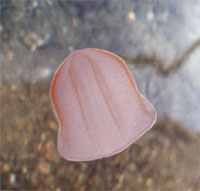
Fig. 1. Outer appearance of Beroe ovata
The new intruder an oval gelatinous body of the oval widening at the oral part (fig. 1). Specimens have pink coloring. Large animals have brighter coloring with brown shade, the young are slightly pink.
Beroe ovata is an obligate predator feeding with ctenophores, particularly – with mnemiopsis. For this reason it is included in species list which are capable to make effect biocontrol on the population of Mnemiopsis (Iarbison, Volovik, 1993; GESAMP, 1997). In this connection AzNIIRKH carries out the monitoring the population of Beroe in a new geographic range, i.e. in the Russian part of the Black sea. The evaluation of spatial and temporal distribution of some biological parameters of its population and other components of the ecosystem was conducted in complex trips in the north-eastern part of the Black sea in spring (March -April) and at the end of summer (end of August - September). In the Azov sea monitoring of the gelatinous including Beroe, was accomplished during the whole vegetative period - from April till October, when the ecological works were conducted.
With the appearance in the Black sea of a new ctenophore, belonging to species Beroe, its specific characteristics and origin were considered. Morphological analysis of meridional canals of the new species carried out, by L.N. Seravin (personal report by T. Shiganova), allowed to distinguish it as Beroe ovata, not Beroe cucumis, according to the definitions of the Ukrainian experts (Y. P. Saitzev, etc.).
Concerning the origin of Beroe, found in the Black sea, two basic versions of possible routes of its intrusion: either from the Mediterranean sea, where it is a constant component of the fauna (Madin et al., 1983) or from the Atlantic coast of North America brought with ballast waters, like its predecessor Mnemiopsis. We consider the first version improbable, as for 6-7 thousand years of its habitation in the Mediterranean and Marmora seas and connection of these basins with the Black sea it could repeatedly, as it is seen with many Mediterranean forms of benthos, plankton and nekton, penetrate into the Black sea. Such phenomenon was possibly met repeatedly in the given period, but by virtue of essential differences in salinity of surface layer, in which Beroe dwells, this species could not get acclimatized in the Black sea basin with lowered salinity, as contrasted to the basins - donors. We consider the second version with more substantial, according to which Beroe was delivered to the Black sea with ballast waters.* Having passed some adaptive period it had an explosive number of population in 1999. At the end of summer of the mentioned year Beroe ovata was marked everywhere in the north-eastern part of the Black sea both in coastal, and in open waters, exclusively in the surface layer, higher than the thermocline line. The average number compounded 1 sp./m2, and biomass - 31 g/m2. The greatest clumps of Beroe coincided with the districts of heightened concentration of Mnemiopsis. In the population of the intruder large specimens prevailed 60-81 mm long and with the mass of 62-77 g. Maximal sizes of the caught animals reached 163 mm. Single small specimens of Beroe 16-18 mm long were met in this period only in the littoral, above the depths of 2-4 m.
The dimensional maximum of frequency distribution of Beroe, caught in the Blue Bag and in district Big Utrish, was 60-90 mm. The number of the young in these places was also minor.
As a whole the sizes of Beroe, caught in the Black sea in the first explosive year, appeared much more larger than are given in the literature for the native habitat. Thus, in the Mediterranean sea Beroe reached the maximal length of 115 mm. In the Narragansett bay the specimens were 10-50 mm long, in the Pacific waters animals of 12-40 mm were met in the catches. The marked feature of the sizes of the Black sea Beroe, is probably connected with a rather high food supply, in this case – with Mnemiopsis, as they consume only these ctenophores (Kamshilov, 1960; Volovik et al., 2000; Shiganova, et al., 2000).
Intensive development of the new intruder in the Black sea was watched in the subsequent 2 years. After a successful wintering Beroe was spread on all the shelf area of the basin by the end of August 2000. The average number reached 22 sp./m2, and biomass - 175 g/m2. These parameters appeared to be higher, than in the first year of number explosion of Beroe. The size structure of the intruder indicated an active breeding of the animal, which was more intensive in the warmed up coastal areas: the young compounded more than 30 % of the total number. This fact is the testimony of successful acclimatization and assimilation by new ctenophore of the Black sea geographic range. Not less intensive development of the Beroe population was watched and 2001. The clumps of ctenophore were marked along the whole north-eastern littoral of the Black sea from the second half of August. The average number compounded 43 sp./m2, varying from 8 to 224 sp./m2. It is twice more, than in 2000. The biomass of the animals reached 109 g/m2. Its maximal value made up 420 g/m2 in the district of cape Iron Horn, (district of the Kerch fore-channel area). The dimensional structure of the population differed noticeably from the given for the previous years. Thus the number of small specimens increased by order, that confirmed a very high intensity of intruder’s breeding. The maximum of frequency distribution of animals by length, caught in the Utrich district in 2001 was in the range from 30 to 50 mm, while earlier (1999-2000) it compounded 80-90 mm. The maximal length of the caught Beroe was 120 mm. The data on a Beroe feeding collected directly in the sea show, that in 2001 the quantity of feeding animals reduced almost twice (tab. 1) and this fact, apparently, was connected with poor trophic supply of the new intruder in this period and decrease of specimens growth rate.
Table 1. Feeding of Beroe in the Black sea
|
total |
Number of checked specimens |
% of feeding specimens |
|||
|
Animal size, mm |
|||||
|
Up to 20 |
20-40 |
More than 40 |
|||
|
2000 |
296 |
11 |
8 |
5 |
24 |
|
2001 |
316 |
1 |
8 |
2 |
11 |
For the first time Beroe appeared in the Azov sea at the end of September, - October 1999 (data of AzNIIRKH). Single specimens were found in its Kerch fore-channel area and further on one of the stations in the central part of the sea. The met specimens were of the large size (60-70 mm). In 2000 Beroe ovata appeared in the Azov sea at the beginning of October and formed a small, but legibly delineated geographic range with a biomass about 12 g/m2 (fig. 2). The data show that the intrusion into the basin and the initial migration of the intruder along the sea are identical to the distribution indices of Mnemiopsis. At the beginning Beroe appears in the southern part of the sea, then it is marked along southeastern and Kuban littoral, particularly it inhabits the central district. This indicates, that the new ctenophore is delivered by the Black sea waters through the Kerch strait and the basic premises for forming the geographic range for Beroe (like Mnemiopsis) are the intensity of advection of the Black sea waters, wind activity and its direction, as well as the concentration of the intruder in the Black sea. The difference is in that fact, that for Beroe and Mnemiopsis these factors have crucial importance in different months of the vegetation period.
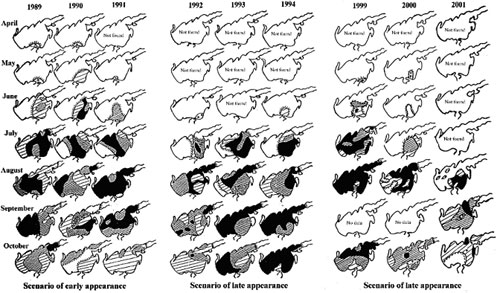
1995

Fig.2. Distribution and biomass of Mnemiopsis in the Azov Sea, g/m3
The sizes of Beroe specimens of the Azov population are various. Very large specimens were met in trawl catches about of the Kerch strait, medium-sized Beroe (length - 20-55 mm) was marked along the southeastern littoral. The availability in plankton net samples of small specimens indicated the breeding of the intruder under conditions of the Azov geographic range that had not been watched earlier.

1995
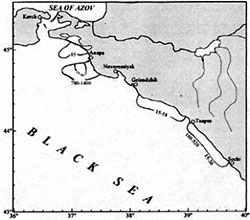
2000
Fig. 3. The abundance of Mnemiopsis (sp./m2) in the north-eastern part of the Black sea in August-September
a – before appearance Beroe ovata
b - after appearance Beroe ovata
Rather negative consequences of the intrusion of Mnemiopsis in the Azov-Black sea basin (Ctenophore..., 2000) have called urgent necessity of studies of some biological characteristics of Beroe ovata in a new geographic range. First of all the character of feeding and composition of nutrition of the intruder was studied. It came out, that Beroe did not digest various kinds of food zooplankton, jelly-fishes, Aurelia, fry of fishes, but fast enough and easily acquires Mnemiopsis and Pleurobrachia. Beroe digests these ctenophore during 3-5 h.. (Shiganova et al., 2000, our data)
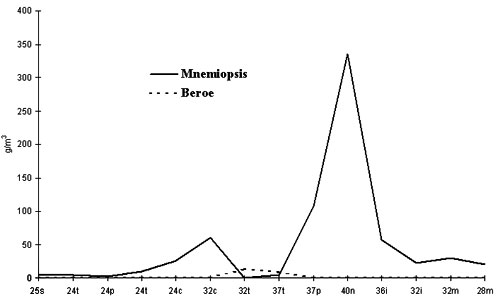
Standard Regions of the Azov sea
Fig. 4. Changes in the biomass of Mnemiopsis and Beroe in the Azov sea in October, 2000
As the calculations show (Shiganova et al., 2000), at such assimilation rate and consumption by the population of Beroe by number 1 sp./m2 1-2 Mnemiopsis specimens per day, the eating away of which compounds 6,5-10 % of the number of victims. These predicted data are acknowledged by rather low number of Mnemiopsis by the September 2000. (fig. 3). Beroe consume especially actively Mnemiopsis specimens of medium and large size, and can completely swallow Mnemiopsis equal in size or even of a bit larger sizes. Small Beroe tear large Mnemiopsis and do it repeatedly in process of digestion. This can explain that fact, that in the Azov sea in the places of detection of Beroe were marked injured specimens of Mnemiopsis and their remains. In the places of Beroe accumulations the falloff of Mnemiopsis number (fig. 4,5) is marked. For the last two years in the shelf waters of the Black sea the biomass of Mnemiopsis reduced by order by autumn (see fig. 3), and in the southern part of the Azov sea – reduced twice. In the Black sea population of Mnemiopsis the percentage of small specimens substantially decreased, which was rather high in the same period of the preceding years (tab. 2).
Table 2. Biomass (g / i3) and dimensional frame (%) of the population of Mnemiopsis on shelf fields of the Black sea before (1993-1995) and after the intrusion of Beroe
|
Years |
Biomass |
Length, mm |
||
|
<10 |
10-45 |
>45 |
||
|
1993 |
42,8 |
Data not available |
||
|
1994 |
21,6 |
39 |
43 |
18 |
|
1995 |
23,6 |
62 |
26 |
12 |
|
Average |
29,3 |
50,5 |
34,5 |
15 |
|
1998 |
8,4 |
25 |
36 |
39 |
|
1999 |
1,1 |
10 |
66 |
23 |
|
2000 |
3,9 |
30 |
59 |
11 |
The data analysis confirms that within 3 past years, when Beroe has appeared in the Russian waters, the biomass of Mnemiopsis becomes lower with every year, and its eating away of the plankton is weaker. Less abundant population winters (150-200 sp./m2, against 500-600 sp./m2), in the years without Beroe, which partially disappears in the cool term particulate and forms by spring very small concentration. In 2000 (fig. 6) it made up only 1-6 sp./i3, against 320 sp./i2 in 1996, when Beroe was not present in the Black sea. At such a low starting concentration of Mnemiopsis in the north-eastern part of the Black sea the development of the Azov population of ctenophore passes under the scenario of late appearance and even less intensively (see fig. 2) with positive consequences for the ecosystem and the stocks of the Azov plankton-eaters - anchovy and tyulka. With these fishes in the last years the period of feeding increases along with high-level development of food supply (first half of summer) and favorable trophic conditions for surviving of larvae of the first (often the strongest) generation of anchovy and the young of tyulka are created. An example to this is the year 2000 (see fig. 2), when the development of Mnemiopsis in the Azov passed under the scenario of late invasion sea because of its poor starting concentrations in Black sea fore-channel area. From May till July on the area of the sea the highly productive zones of the zooplankton were formed, which in a sufficient extent ensured the flock of plankton-eaters with and their young with nutrition in the first half of fattening period. This resulted in raise of both fat content and fatness of anchovy and tyulka.
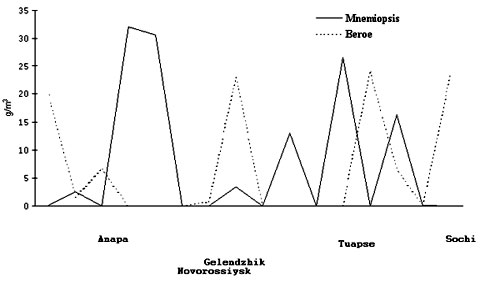
Fig. 5. Changes in the biomass of Mnemiopsis and Beroe in the Black sea in August-September, 2001
With the appearance of Beroe in the Black sea, which reduced the number of Mnemiopsis with its preying, the biomass of food zooplankton began to correspond to the "pre- ctenophore "level (fig. 7). The assemblage of food organisms had a chance to implement to the maximum potential productional abilities in the warm period of year. This fact, as it is known, results in augmentation of stocks of planktiverous fishes and decrease losses caused by Mnemiopsis in the preceding years.
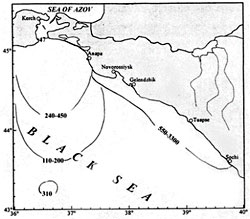
1996

2001
Fig. 6. The abundance of Mnemiopsis (sp./m2) in the north-eastern part of the Black sea in April
a – before appearance Beroe ovata
b – after appearance Beroe ovata
In the past years there have been structural changes in the community of the Black sea zooplankton. Specific diversification of summer-autumnal complex enriched. Instead of 6-7 species 10-11 species are nowadays marked. For the first time for many years of absence a large copepod Pontella mediterranea was sampled, which earlier was rather often met in near-surface waters. The number of inhabitants of surface layer of the water column such as thermophilic species Centropages ponticus and eurythermal copepoda Acartia clausi increased. Before the appearance of Beroe the biomass of the summer-autumn zooplankton almost equally was formed by copepoda and - sagittas. Cladocera, most intensively eaten away by Mnemiopsis, compounded no more than 20 % of food biomass, and within the years of maximal development of Mnemiopsis - only 1 %. In the past time the copepoda complex has become leading, its number in samples increased almost by 20 times. Besides the age structure of different copepoda species. Populations of cladocera include all phases of development, including the most important, from the point of view of trophic supply of larvae of plankton-eaters, - nauplia and small copepodites. Their sufficient quantity is a basis of forming fruitful generations of planktiverous fishes. With appearance of Beroe the number of eggs and larvae of anchovy, jack mackerel and other fishes, as well as specific diversification of ichthyoplankton as a whole increased. Thus, in 2001 the number of eggs of anchovy in Kerch-Tamanski region compounded 23 sp., against 15 sp. on average annual data, and in Caucasian region- 1400 sp., against 34 sp. (data by V.P. Nadolinski ).
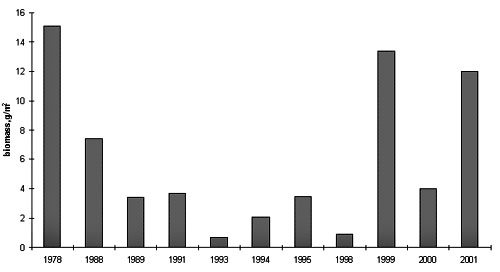
Fig.7. Changes in the biomass of food zooplankton in August-September in the Black sea over many years
(data for the period of 1984-1992 are given after Vinogradov et al., 1992)
Thus, the appearance of ctenophorea Beroe ovata in the Black sea, resulted in biocontrolling the development of the population of Mnemiopsis, essentially influenced the structural and productional characteristics of planktonic community, therefore the alimentary pelagic chains are restored, as well as the stocks of plankton-eaters broken and violated by Mnemiopsis. This allows to make up the conclusion, that the recommendations, presented to the public at the beginning of the 90-s, that the intrusion of Aeroe ovata in the Azov-Black sea basin would be effective biocontrol the population of Mnemiopsis (Harbison, Volovik, 1993) were completely justified.
Literature
1. Zaitzev Y.P. Marine hydrobiological examinations of the National Academy of Sciences of Ukraine in 1990-s of the 20 century. Shelf and waters of the incline of the Black sea // the Hydrobiological journal, 1998. O, 34. V. 6. – P. 3-21.
2. Ignatiev N.I. Zuev G.V. Ctenophore Beroe ovata Brunguiere, 1789 in the Black sea. // Thesis of the report at scientific seminar " Kinds-intruders in the European seas of Russia. Murmansk. 2000a.
3. Kamshilov M.M.. Feeding of ctenophore Beroe cucumis Fab / / Report of. SA of the USSR 1960a. O. 130. ?5. pp 1138-1140.
4. Volovik S.P. (edit.) Ctenophore Mnemiopsis leidyi (A.Agassiz) in the Azov and Black seas: biology and consequences of intrusion. – AzNIIRKH, Rostov-on-Don. 2000, - 500 p.
5. Shiganova T.A., Bulgakova Y.V., Volovik S.P., Mirzoyan Z.A., Dudkin S.I. New intruder Beroe ovata and its affect on the ecosystem of the Azov-Black sea basin in August - September 1999 // In “Ctenophore Mnemiopsis leidyi (A.Agassiz) in the Azov and Black seas: biology and consequences of the intrusion” (edit. Prof. S.P. Volovik) – AzNIIRKH, Rostov-on-Don. 2000. – P. 432-450.
6. Madin L., Cetta P. and Dietzmann G.R. Feeding rates and prey selection in oceanin ctenofores. Trans. Am. geofys. Un. 64. 1983. – P. 1071-1072.
7. Harbison G.R. and Volovik S.P. Methods for the Control of the Ctenophore Mnemiopsis leidyi in the Black and Asov seas. FAO Fisheries Report. - N 495. Rome, 1993. – P. 32-34.
8. GESAMP. Opportunistic settlers and the problem of the ctenophore Mnemiopsis leidyi invasion in the Black sea // GESAMP Reports and studies. London SEI 7SP. No 58. 1997. P. 1-86.
9. Konsulov A., Kamburska L. Ecological determination of the new Ctenophore Beroe ovata invasion in the Black sea // Tr. Ins. Oceanology. BAN. Varna. 1998. P. 195-197.
Document Actions
